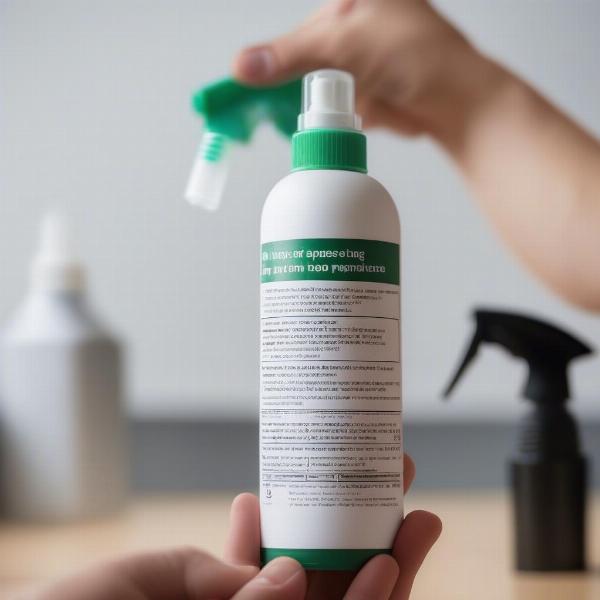Finding the best flea spray for your canine companion can feel overwhelming with so many options available. This article will guide you through everything you need to know about flea sprays for dogs, from understanding the ingredients to choosing the right product for your dog’s specific needs. We’ll cover safety precautions, application tips, and even address some common concerns about flea and tick prevention.
Understanding Flea Sprays and Their Importance
Fleas aren’t just a nuisance; they can cause serious health problems for your dog, ranging from skin irritation and allergies to transmitting diseases. Flea sprays offer a direct way to eliminate these pests and prevent infestations. They work by killing adult fleas on contact and, depending on the formulation, can also offer residual protection to prevent future infestations. Choosing the correct flea spray is crucial for your dog’s health and well-being.
Types of Flea Sprays Available
There are various types of flea sprays on the market, each with its own set of active ingredients and mechanisms of action. Some common types include:
- Natural Flea Sprays: These sprays typically utilize essential oils or plant-based extracts like pyrethrin, derived from chrysanthemums. They are a good option for owners seeking a more natural approach, but their effectiveness can vary.
- Synthetic Flea Sprays: These sprays contain synthetic insecticides like permethrin, fipronil, or imidacloprid. They are generally more potent and offer longer-lasting protection. However, it’s crucial to choose a product specifically formulated for dogs, as some insecticides used for other pests can be toxic to canines.
- Combination Sprays: These sprays target multiple parasites, such as fleas, ticks, and mosquitoes. They provide comprehensive protection but may contain a higher concentration of chemicals.
Choosing the Right Flea Spray for Your Dog
Selecting the appropriate flea spray involves considering several factors, including your dog’s age, breed, size, health condition, and lifestyle.
Considering Your Dog’s Age and Health
Puppies and senior dogs have more sensitive skin and may require specially formulated, gentler sprays. Always consult with your veterinarian before using any flea spray on a puppy younger than 12 weeks or a dog with pre-existing health conditions.
Lifestyle and Environmental Factors
If your dog spends a lot of time outdoors, especially in wooded or grassy areas, you may need a spray with stronger and longer-lasting protection against ticks as well as fleas. Similarly, dogs who swim frequently might need a water-resistant formula.
How to Apply Flea Spray Safely and Effectively
Always follow the manufacturer’s instructions carefully. Here are some general guidelines:
- Wear gloves: Protect your skin from contact with the spray.
- Apply outdoors or in a well-ventilated area: Avoid inhaling the spray.
- Part your dog’s fur: Ensure the spray reaches the skin.
- Apply evenly: Cover your dog’s entire body, avoiding the eyes and face.
- Don’t over-apply: More is not better and can be harmful.
 Carefully Reading Flea Spray Instructions
Carefully Reading Flea Spray Instructions
Common Concerns about Flea Sprays
Some dog owners are concerned about the chemicals in flea sprays. While it’s important to choose a product that is safe for your dog, modern flea sprays are generally safe when used as directed. If you have concerns, discuss them with your veterinarian. They can help you select the best and safest option for your dog.
Conclusion
Protecting your dog from fleas is a vital part of responsible pet ownership. Flea sprays offer a convenient and effective solution. By understanding the different types of sprays, considering your dog’s individual needs, and following proper application techniques, you can keep your furry friend flea-free and healthy. Don’t hesitate to consult your veterinarian if you have any questions or concerns.
FAQ
- How often should I apply flea spray to my dog? Always follow the manufacturer’s instructions. Most sprays recommend monthly application, but some may offer longer protection.
- Can I use flea spray on puppies? Consult your veterinarian before using flea spray on puppies younger than 12 weeks.
- What should I do if my dog has an allergic reaction to flea spray? Immediately bathe your dog with mild soap and water and contact your veterinarian.
- Are natural flea sprays as effective as synthetic ones? Natural sprays can be effective, but their potency and duration of protection may vary. Discuss options with your vet.
- Can I use dog flea spray on my cat? No, never use dog flea spray on a cat. Many flea sprays formulated for dogs contain permethrin, which is toxic to cats.
- What if my dog licks the flea spray after application? A small amount of ingestion is usually not harmful, but contact your veterinarian if you are concerned.
- Can I use flea spray in combination with other flea and tick preventatives? Consult your veterinarian before combining products, as some combinations can be harmful.
ILM Dog is your trusted resource for expert dog care advice, offering guidance on everything from breed selection to health and nutrition. Whether you’re a seasoned dog owner or just starting out, our articles provide valuable insights to help you provide the best possible care for your furry friend. We cover a wide range of topics including breed selection, health and wellness, training and behavior, nutrition, grooming, and product recommendations. Learn more about how we can help you navigate the world of dog ownership by contacting us at [email protected] or calling us at +44 20-3965-8624. Visit ILM Dog for more information.